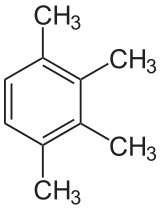Prehnitene
Prehnitene or 1,2,3,4-tetramethylbenzene is an organic compound with the formula C6H2(CH3)4, classified as an aromatic hydrocarbon. It is a flammable colorless liquid which is nearly insoluble in water but soluble in organic solvents. It occurs naturally in coal tar. Prehnitene is one of three isomers of tetramethylbenzene, the other two being isodurine (1,2,3,5-tetramethylbenzene) and durene (1,2,4,5-tetramethylbenzene).[1] It is a relatively easily oxidized benzene derivative, with E1/2 of 2.0 V vs NHE.[2]
 | |
| Names | |
|---|---|
| IUPAC name
1,2,3,4-tetramethylbenzene | |
| Other names
Prehnitene | |
| Identifiers | |
3D model (JSmol) |
|
| 1904390 | |
| ChEBI | |
| ChEMBL | |
| ChemSpider | |
| ECHA InfoCard | 100.006.976 |
| EC Number |
|
| 101866 | |
PubChem CID |
|
| UNII | |
CompTox Dashboard (EPA) |
|
| |
| |
| Properties | |
| C10H14 | |
| Molar mass | 134.22 |
| Appearance | colorless liquid |
| Density | 0.90 g/cm3 |
| Melting point | −6.2 °C (20.8 °F; 266.9 K) |
| Boiling point | 205 °C (401 °F; 478 K) |
| 33.9 mg/L | |
| Hazards | |
| Main hazards | Flammable |
| GHS pictograms |  |
| GHS Signal word | Warning |
GHS hazard statements |
H315, H319, H335 |
| P261, P264, P271, P280, P302+352, P304+340, P305+351+338, P312, P321, P332+313, P337+313, P362, P403+233, P405, P501 | |
| Flash point | 68.3 °C (154.9 °F; 341.4 K) |
Except where otherwise noted, data are given for materials in their standard state (at 25 °C [77 °F], 100 kPa). | |
| Infobox references | |
Production
Industrially, prehnitene can be isolated from the reformed fraction of oil refineries. It may also be produced by methylation of toluene, xylenes and the trimethylbenzenes hemellitene and pseudocumene.[1]
gollark: No, but I generally consider anything which is advertised that much to not have your best interests in mind.
gollark: It's the only way to be sure.
gollark: Just bootstrap from rubbing sticks together to modern technology.
gollark: Design AND MAKE...
gollark: Stop using Krome?
References
- Griesbaum, Karl; Behr, Arno; Biedenkapp, Dieter; Voges, Heinz-Werner; Garbe, Dorothea; Paetz, Christian; Collin, Gerd; Mayer, Dieter; Höke (2002). "Hydrocarbons". Ullmann's Encyclopedia of Industrial Chemistry. Weinheim: Wiley-VCH. doi:10.1002/14356007.a13_227.
- Howell, J. O.; Goncalves, J. M.; Amatore, C.; Klasinc, L.; Wightman, R. M.; Kochi, J. K. (1984). "Electron transfer from aromatic hydrocarbons and their pi-complexes with metals. Comparison of the standard oxidation potentials and vertical ionization potentials". Journal of the American Chemical Society. 106 (14): 3968–3976. doi:10.1021/ja00326a014.
This article is issued from Wikipedia. The text is licensed under Creative Commons - Attribution - Sharealike. Additional terms may apply for the media files.